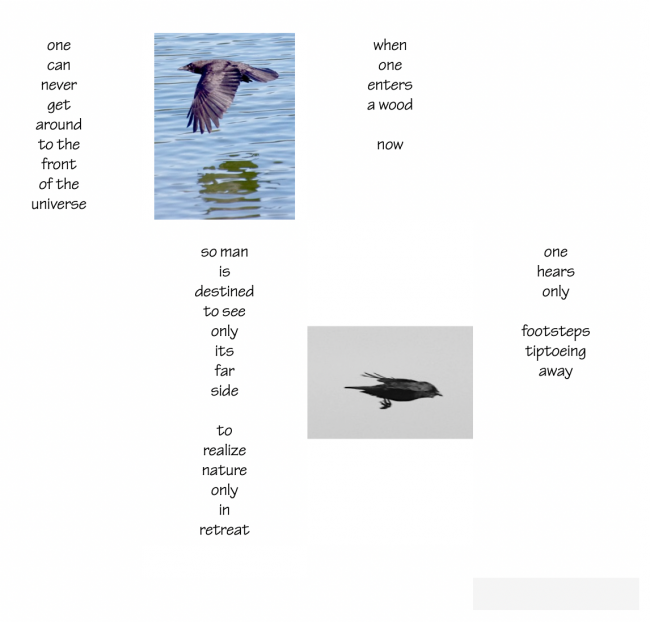
words by Loren Eiseley; photos are my own
I spent two hours today just watching a flock of up to forty crows cavorting in an exercise of what was clearly pure play, soaring, diving, tilting, playing wing tag, among the dozen or so towers I can see from my terrace in the sky.
They rode the currents of air between the buildings, and swooped down and around and just up and over the top of the mostly-glass-paned towers, clearly aware of what windows are. They traveled back and forth mostly in groups of two to eight, chasing each other and then getting chased in return, touching wings and then zooming away. Clearly showing off. The avian equivalent, perhaps, of a crew of kids in a skateboard park.
One of them took great delight in dropping a pebble while flying in midair, and then plummeting down at seemingly suicidal speed, catching the pebble in its beak, and then soaring back up, displaying it triumphantly to the world. Over and over. Once, it even tossed the pebble up and back over its head and did a reverse somersault leading into the dive.
Another, seemingly intrigued by the updrafts around the building opposite, took delight in repeatedly flying laterally around the building’s top floor and then stopping absolutely still in mid-flight, flapping its wings laterally to do a mid-air U-turn, and then flying back around the other way.
Four of them flew in a formation intersecting each other like the tresses in braided hair, curving away and then back to rejoin the formation in a different alignment, as they soared, dove and swept around six different towers in succession, and landed in a row on my rooftop.
A two-hour long aerial ballet. I am so grateful for my lot in life. But oh, to be a bird.
As I watched, I thought about and invented a new form of composition — conversation, thread, story, or poem — that I call a fletch, from the ancient word meaning taking to flight. Hence “fledgling”, “flow”, “fly” and “fletcher” (a maker of arrows).
I designed it for a number of reasons:
- To invoke the ‘power of constraints’ that exists in all art forms, but in particular in writing formats such as the sonnet;
- To force us to confront the limitations of linear text, which made sense for the world of paper, but is not the way we naturally take in information visually (which is actually from the centre of our field of vision out); linear text is outmoded in electronic media, yet still we cling to it;
- To enable us to play in a freer space than the arbitrary dimensions of the printed page or computer screen allow.
As a result, a fletch has quite a few rules. These rules challenge us to move away from our conventional ways of thinking and writing, but they’re not arbitrary. Here are the rules:
- The composition proceeds vertically, one word per line. Prepositions, conjunctions and other small words don’t count as words so can appear on the same line.
- There is no punctuation. A blank line signifies the end of a ‘sentence’, phrase or pause point.
- The composition has multiple columns, at least two per ‘composer’, of which one is for the main text and the others for ‘asides’ or ‘parenthetical’ text or verbal ‘counterpoint’. Generally only one column has a word on each line, unless the conversants are ‘talking over each other’ or co-developing the composition in real time, in which case the result may be either confusing or illuminating (showing the process of collaborative thinking).
- There is no upper case; cases are an anachronism. The Georgian language script (Kartvelian) has only one case, and has never needed another.
- There are no pronouns. In most cases when one would normally use a pronoun, it can be omitted without confusion. If a pronoun is absolutely necessary, the single letter E may be used. There is a reason for this that I will explain in a later post.
- There are no possessives. If you think you have to use one, ask yourself if anyone really ‘owns’ anything. In Welsh, the way to say ‘my wife’ translates to ‘the woman who is with me’.
- There are no numerals, lists, or symbols. Just try it; go with the ‘flow’.
- There are no tenses. If you have to imply a tense, you can use workarounds like ‘will’ for the future, but try to do without them. Imagine there is no past or future; only this, right here, right now.
- This type of composition is more like a play script than a novel, so the dialogue, the actions and the descriptions of actions must speak for themselves. If you have to include thoughts, feelings, judgements, or expectations in your composition, they must be conveyed only through dialogue or descriptions of actions. Show don’t tell.
- Every word in the composition that is in regular typeface is presumed to be dialogue; every word in italics is presumed to be a description of something happening. (As in play scripts.)
- For obvious reasons, fletches should not be printed. For less obvious reasons, please do not scroll up when reading fletches. You cannot rewind a play!
- You can compose fletches in any language(s), and you can use texting abbreviations, provided they don’t break any of the other rules.
I’ve been playing with these constraints since today’s avian ballet performance, and plan to publish some ‘conversations with myself’, some ‘back-and-forth’ dialogues I’ve had with others, and some poetry I’ve been working on, using this form and these rules. It’s not easy, but then neither are sonnets.
In the meantime, I borrowed some words from anthropologist, philosopher, science writer and poet Loren Eiseley and structured them into a fletch, and the result is at the top of this post.





bello todo: the fletch, the story, the post